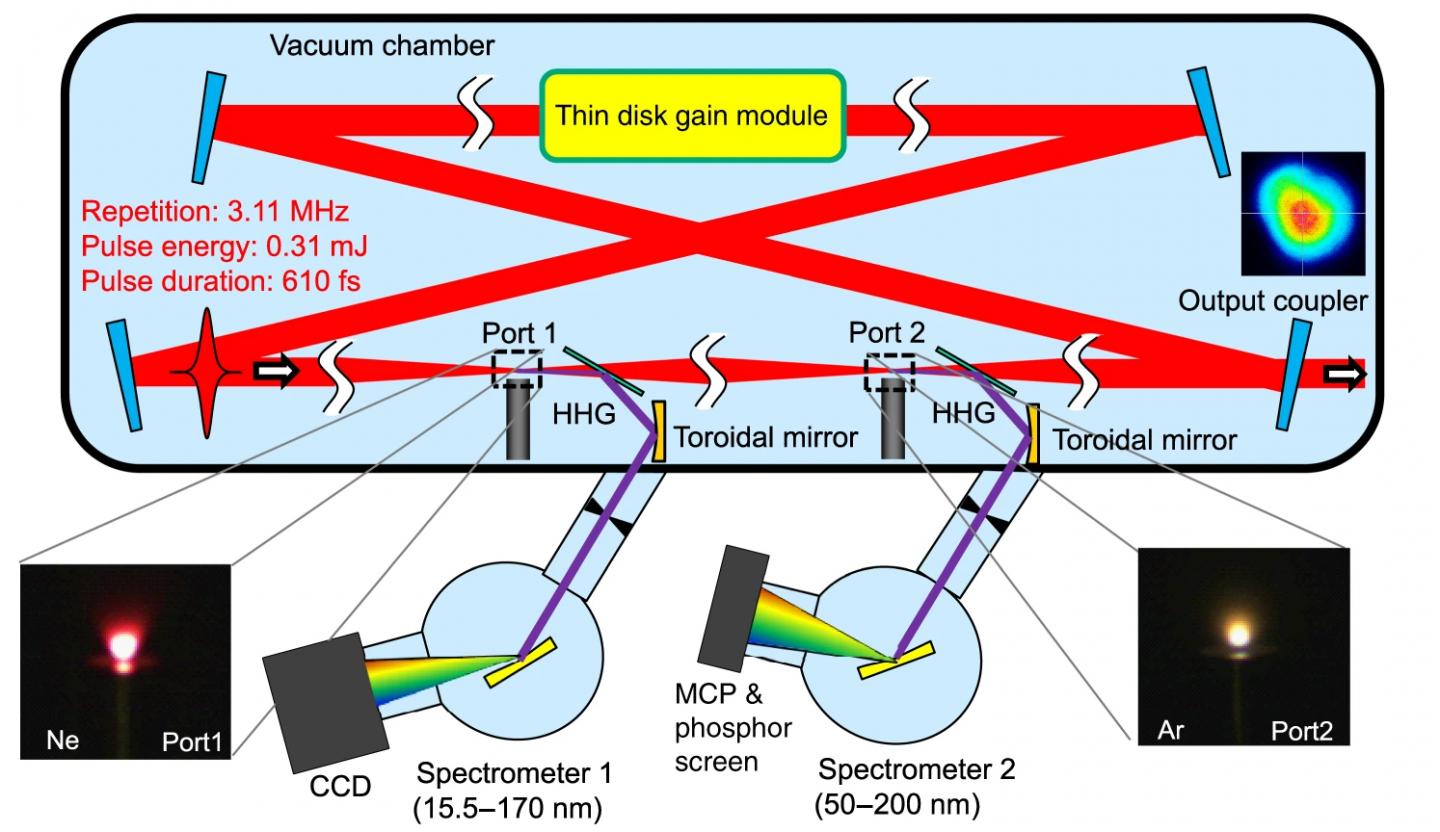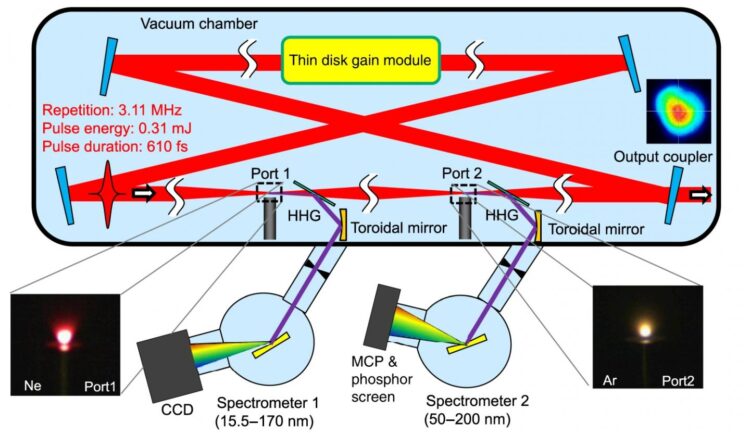A new machine to probe the ultrafast motion of matter is the first of its kind

Credit: © 2020 Springer Nature
Researchers have established a novel high-frequency laser facility at the University of Tokyo. The coherent extreme ultraviolet light source can reveal details of biological or physical samples with unprecedented clarity. It also allows for investigation of time-dependent phenomena such as ultrafast chemical reactions. Existing facilities for such investigations necessarily require enormous particle accelerators and are prohibitive to many researchers. This new facility should greatly improve access for a broad range of researchers.
You are probably familiar with ultraviolet (UV) light and X-rays. UV light from the sun helps your body produce vitamin D and makes solar panels generate power, and X-rays can be used to image the inside of your body to find broken bones or other ailments. But beyond these aspects, UV light and X-rays are also essential tools for the investigation of the physical world. Researchers use these forms of light to reveal details of biological, chemical and physical samples such as their makeup, structure and behavior.
Two kinds of light which are especially useful for state-of-the-art investigations into fast-acting phenomena, such as certain chemical reactions or biological processes, are coherent extreme ultraviolet (XUV) and soft X-ray pulses. These are both very precise forms of light with finely controlled parameters, akin to laser pulses, crucial for performing good rigorous experiments. However there are some drawbacks to how these beams are made.
“Facilities to produce coherent XUV and soft X-rays are huge machines based on particle accelerators — like smaller versions of the Large Hadron Collider in Europe,” said Professor Katsumi Midorikawa from the UTokyo Institute for Photon Science and Technology and RIKEN Center for Advanced Photonics. “Given the rarity of these facilities and the expense of running experiments there, it presents a barrier to many who might wish to use them. This is what prompted myself and colleagues at UTokyo and RIKEN to create a new kind of facility that we hope will be far more accessible for a greater number of researchers to use.”
The new XUV source facility is much, much smaller than any that has come before it. It is housed inside a relatively modest lab underground at the University of Tokyo. The bulk of the machine is a 5-by-2-meter vacuum container housing a 100-meter-long ring, or resonator, down which a high-power laser light is stored. At two locations on this coil are pockets of special rare gases that alter characteristics of the passing laser. This results in the two separate beams of XUV and soft X-rays, which are cast onto samples undergoing investigation. Light reflected off the samples is then read by high-speed imaging sensors.
“What is really novel about our approach is that the XUV and soft X-ray pulses are extremely short but occur at very high frequencies, in the region of megahertz, or millions of cycles per second,” said Midorikawa. “For perspective, established XUV facilities that use synchrotron radiation pulses also in the megahertz region have longer bursts which are less suitable for resolving dynamic phenomena. And those that use so-called X-ray-free electron laser sources have short pulses, but offer low frequencies of around 10 hertz to 100 hertz. So our facility offers the best of both worlds, with the added benefit of being only a fraction of the size and with far lower operating costs.”
This new XUV source offers ultrashort pulses, useful for probing fast phenomena, and high frequencies, useful for investigating the structure and chemical properties of matter. This is possible, due to the process that creates the pulses as the laser interacts with the gas. It is called high-order harmonic generation and also because of this, the facility is the first of its kind capable of producing multiple XUV and soft X-ray beams.
“I have been working in the field of XUV generation and application for 30 years. Although high-order harmonic generation brought a breakthrough in this field, the generation efficiency and pulse repetition rate were still insufficient for many applications,” said Midorikawa. “When I proposed the idea of this facility to my colleagues, they were instantly interested and we were able to acquire a suitable budget to complete it. We all hope this will open the door to new research from materials scientists, chemists and biologists who can finally access this amazing and powerful investigative tool.”
###
Journal article
Natsuki Kanda, Tomohiro Imahoko, Koji Yoshida, Akihiro Tanabashi, A. Amani Eilanlou, Yasuo Nabekawa, Tetsumi Sumiyoshi, Makoto Kuwata-Gonokami & Katsumi Midorikawa. Opening a new route to multiport coherent XUV sources via intracavity high-order harmonic generation. Light: Science & Applications volume 9, Article number: 168 (2020).
https:/
DOI: 10.1038/s41377-020-00405-5
N.K. gratefully acknowledges the support from the special postdoctoral researcher program of RIKEN. K.M. and Y.N. thank the financial support from Grants-in-Aid for Scientific Research Nos. 26247068, 26220606, and 19H05628. This research was supported by the Photon Frontier Network Program; the Special Coordination Funds for Promoting Science and Technology; and the Center of Innovation Science program of the Ministry of Education, Culture, Sports, Science and Technology.
Useful links
Institute for Solid State Physics – http://www.
Photon Science Center – http://www.
RIKEN Center for Advanced Photonics – https:/
Research Contacts
Professor Katsumi Midorikawa
RIKEN Center for Advanced Photonics
2-1 Hirosawa, Wako, Saitama 351-0198, JAPAN
Tel: +81-48-467-9492
Email: [email protected]
Press Contact
Mr. Rohan Mehra
Division for Strategic Public Relations, The University of Tokyo
7-3-1 Hongo, Bunkyo-ku, Tokyo 113-8654, JAPAN
Email: [email protected]
About the University of Tokyo
The University of Tokyo is Japan’s leading university and one of the world’s top research universities. The vast research output of some 6,000 researchers is published in the world’s top journals across the arts and sciences. Our vibrant student body of around 15,000 undergraduate and 15,000 graduate students includes over 4,000 international students. Find out more at http://www.
Media Contact
Katsumi Midorikawa
[email protected]
Original Source
https:/
Related Journal Article
http://dx.





